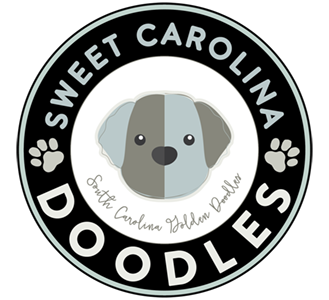Introducing Your Dog to a New Baby
As a lover of puppies, we keep our eyes on all things puppy and dog related. During one of our daily internet searches, we found this great article that shares how to introduce your dog to a new baby. The article is copied below and can be found in full here.
AUTHOR: PUPPYSPOT
Bringing home a new member of the family is a special occasion filled with joy and new beginnings. But with the start of something new, it’s difficult to know just how some will react (particularly, your first furry baby). Of course, a newborn baby requires a great deal of attention, which inevitably means time taken away from the family dog. That said, there are ways to ensure the transition goes as smoothly as possible for all involved.
Preparation Pre-Due Date
Make your dog more comfortable with a new addition to the family by teaching your dog the proper obedience a few months ahead of time, before the stork arrives. Start introducing your dog to new sights, sounds, smells and experiences. Especially if your dog has never been around children, you should socialize him to behave comfortably around young ones who might have less awareness of personal space than their older human counterparts. Take your dog places like a dog park or to a family member’s house with children and allow him to observe kids from a distance before slowly making safe contact with them. Also allow him to sniff out the baby’s stroller, crib and related products which will soon become a daily part of the family’s new life. A month or two before the baby arrives, start implementing any changes in schedule that are anticipated for when the baby comes. If you know you won’t have as much time to play with your pup, make playtime short but meaningful, and eventually your dog will get into a new groove. By the time Baby comes home, your dog will already feel some sense of familiarity.
Coming Home
While Mama recovers in the hospital, have a loved one bring home one of the baby’s blankets for the dog to smell. It’s better that he gets used to the baby’s scent now than for him to have sensory overload when the baby arrives. When arriving home from the hospital, let someone else hold the baby as Mom receives a warm welcome and excited kisses from the pup who missed her. Your dog can sense any emotions you have, so whether you’re feeling stressed or excited, make sure you put on a calm face when it comes time to finally having your dog and baby meet face-to-snout. Keep your dog leashed, use cues such as “back up” (a command ideally taught before the baby’s due date), and reward your dog with treats and praise for his good behavior so that he only associates the baby with good feelings.
Daily Life as a New Family
Though it might seem like a good idea to switch your time between baby and puppy, it’s actually much more beneficial to shower your dog with attention, praise and treats while the baby is around. That way, your dog will learn to love the baby as much as you do—albeit for different reasons. While balancing your attention between two needy “children” requires a great deal of multitasking and patience, even small gestures like happily talking to your dog while the baby is in your lap can make a big difference in keeping your dog happy and content with having the baby around. As your child grows to be more hands-on, your dog may receive some unwanted pulling and tugging. To prepare your dog, give him small, friendly tugs or pinches, then reward him with a treat. He will gradually learn to tolerate unwarranted touching from your baby. One very important tip to keep in mind throughout your dog’s acclimation process is that you should not punish your dog for aggressive behavior such as growling or barking in front of the baby. The outcome will be a dislike of situations in which the baby is involved, and he may even strike without any warning signs next time. Instead, you should implement continuous training to reward situations which involve your dog and baby together. Seek professional guidance if your dog’s behavior appears to pose a threat to your child’s safety.
Welcoming a new child into the family is a big change on many levels, but it doesn’t have to be a scary one with your pooch involved. Through small preparations and repeated positive reinforcement, your dog will learn to cherish the new addition to your family.


